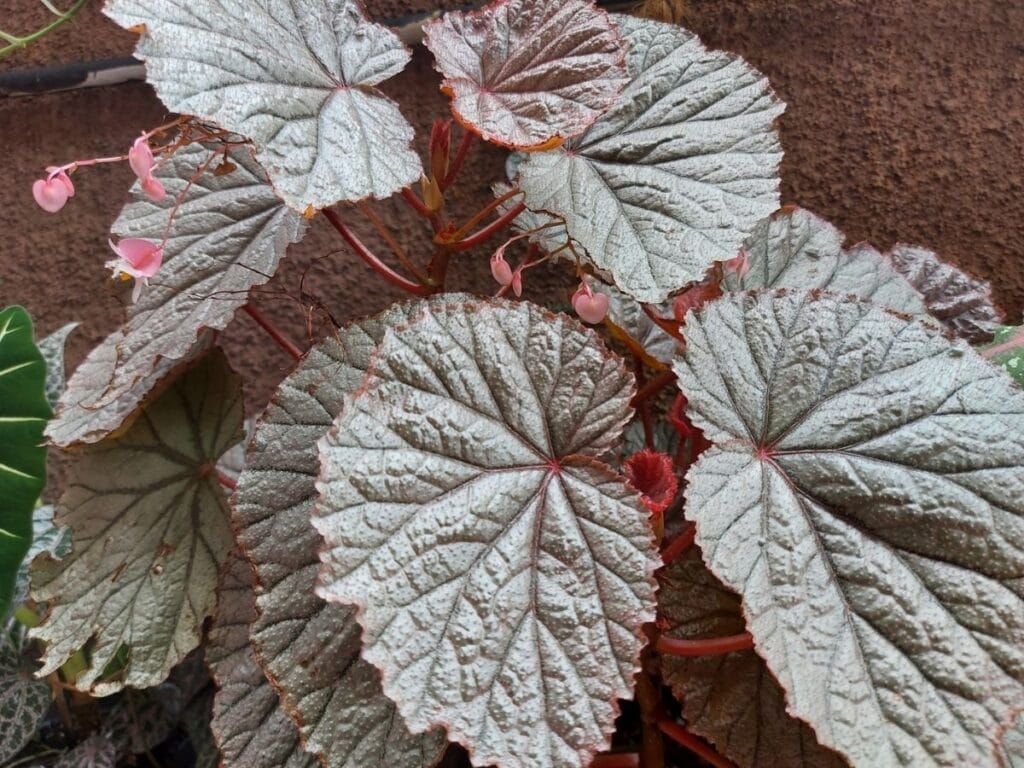Begonia Rex, or Rex Begonia, is a type of begonia that is known for its interesting and colorful foliage.
If you are looking for a plant that can add some color to your garden, Begonia Rex is a great option. You can grow Rex begonias in hanging baskets, on windowsills, or as pets. In this article, we will provide you with tips on how to grow and care for Begonia Rex.
Keep reading to learn more!
Plant Facts
| Botanical name | Begonia rex-cultorum |
| Common names | Rex begonia, painted leaf begonia |
| Family | Begoniaceae |
| Plant Type | Houseplant |
| Height and Width | 12-18” tall and wide |
| Origin | Northeastern India, Vietnam, southern China |
| Flower colors | None |
| Foliage color | Green, red, silver, or purple |
| Sun Exposure | Partial to full shade |
| Soil Type & pH | Well-drained, acidic soil |
| Special features | Toxic to animals, semi-tropical, great for containers, perfect for shade |
How to Grow Rex Begonias
Propagation
To propagate a rex begonia, you can take leaf cuttings from the plant.
Cut the stem off all the way back to the base of the leaf, and cut the leaf into wedges from the parent plant. Prepare a sharp knife and locate the main veins on the begonia leaf.
Cut from the leaf edges all the way back to where the stem once was. Place the leaf cutting into a container with moist peat moss and keep it under fluorescent lights or on a bright window ledge out of direct sunlight.
Wait for growth, and rooting will take place in a week or two, and you should have new plants in a month or two.
Soil
Begonias are beautiful, unique flowers that come in a wide variety of colors and patterns. They’re also relatively easy to care for, which makes them a popular choice for both experienced gardeners and beginners alike.
One of the keys to keeping begonias healthy is to choose the right type of soil. Unlike many other plants, begonias prefer alkaline soil with a pH level of 6.5-7.5.
The soil should also be well-draining; avoid soggy soil to prevent root rot. In addition, begonias need plenty of moisture, so be sure to water regularly.
With the proper care, your painted leaf begonia will thrive and provide you with years of enjoyment.
Pruning
As any gardener knows, pruning is an essential part of plant growth care. Not only does it help to keep plants healthy and vigorous, but it can also encourage new growth and improve the overall appearance of a garden. When it comes to begonias, there are a few things to keep in mind.
First, begonias are best pruned when they are actively growing. In the winter months, Rex begonias go through a dormant stage during which they lose their distinctive leaves. This means that late spring or early summer is the ideal time to do it.
Second, begonias should be pruned after they have flowered. This will help to ensure that the plant has enough energy to produce new flowers.
When pruning begonias, be sure to use sharp, clean shears. This will help to prevent damage to the plant and encourage neat, tidy growth. With these tips in mind, pruning begonias is a simple and straightforward task that any gardener can do.
It is also important to remove dead leaves from the plant as they can attract pests and diseases and hinder the growth of new leaves and flowers. Be sure to dispose of the dead leaves properly and avoid composting them.
Repotting and Transplanting
While they are generally easy to care for, rex begonias do require some special attention when it comes time to repot or transplant them. Here are a few tips on how to successfully repot and transplant a rex begonia:
When repotting rex begonias, choose a pot that is only slightly larger than the one the plant is currently in. Begonias prefer to be slightly pot-bound, so going too much larger can lead to problems with watering and drainage. It’s also important to use a well-draining potting mix that contains perlite or vermiculite to help combat root rot.
When transplanting, it’s best to wait until early spring when the plant is just beginning to grow actively. Gently loosen the roots and carefully remove the plant from its current pot. Plant it in the new location at the same depth it was previously growing, and water thoroughly. Be sure to choose a spot that receives filtered light – too much direct sunlight can scorch new leaves. With a little care, your
How to Care for Rex Begonias
Rex begonias are beautiful, exotic plants that are prized by many gardeners. While they are not the easiest plants to care for, with a little bit of effort, you can enjoy these stunning specimens in your own home. Rex begonias prefer filtered light and consistently moist soil. They will also require regular misting to maintain high humidity levels.
Here are our begonia rex care tips to follow:
Water
Rex begonias are one of the most popular houseplants because of their beautiful, variegated leaves. Though they’re relatively easy to care for, they do have some specific watering needs.
Rex begonias should be watered thoroughly, but allowed to dry out between waterings. They’re also sensitive to fluoride, so it’s best to use filtered or distilled water.
When watering rex begonias, be sure to avoid getting water on the leaves, as this can cause brown spots. Instead, water at the base of the plant, taking care not to let the root system sit in water. With a little care, your rex begonia will thrive and add a splash of color to your home.
Sunlight
Because they are native to tropical regions, Rex begonias enjoy indirect sunlight, partial shade, and full shade. They will tolerate some direct sun, but too much direct sun can scorch their showy leaves. If you are growing rex begonias indoors, place them near an east- or west-facing window or in full shade.
Outdoors, they will do best in a shady spot with dappled sunlight.
Temperature and Humidity
Rex begonias also prefer warm temperatures. They will not tolerate frost and should be brought indoors if cool temperatures fall below 60 degrees Fahrenheit.
However, they also do not like it when the air is too dry. To help maintain the proper humidity level for your rex begonia, you can mist foliage plants or set their pot on a tray of pebbles filled with water.
There are a few easy ways to maintain the right plant conditions. First, consider placing your plants near a window where they can get indirect sunlight. This will help to regulate the temperature and prevent the air from becoming too dry, while also providing good air circulation.
You can even grow your plant atop a pebble tray, which will allow you to provide the right amount of humidity without causing the roots of the plant to become saturated.
You can also install a humidifier in your home to increase the humidity levels and prevent dry air.
Fertilizer
Fertilizing Rex begonias is important to ensure they thrive. These plants are native to the tropics and prefer humid conditions with filtered sunlight or complete shade.
The best way to fertilize these perennials is to use a water-soluble fertilizer that is high in phosphorus. Phosphorus promotes root growth. Fertilize every two weeks during the growing season, from spring to fall.
Be sure to dilute the fertilizer solution according to the package instructions, as too much fertilizer can burn the leaves. Apply the fertilizer solution to the soil around the plant, being careful not to get any on the leaves.
Water the plant well after fertilizing. With proper care, your Rex begonia will reward you with beautiful blooms all season long!
Pest and diseases
Rex begonias are beautiful plants that can be grown indoors or outdoors. However, they are prone to several diseases and pests that can affect their health.
Some common diseases that you may face with your Rex begonia plant include bacterial leaf spot, powdery mildew, botrytis, Pythium root rot, and Rhizoctonia crown rot. These diseases can cause water-soaked areas on leaves surrounded by yellow rings, brittle and discolored young leaves, and other symptoms.
To prevent these diseases, it’s important to avoid overwatering your Rex begonia plant. Allow the top inch of soil to dry out before watering again, and ensure that the pot has proper drainage holes to prevent water from pooling around the roots. Additionally, be mindful of the type of potting soil you use.
Some common pests that could affect your Rex begonia plant are mites, mealy bugs, scale, whiteflies, nematodes, and slugs/snails. These pests can cause stunted growth and other problems. You can use traps, pellets, or a systemic fungicide may be used as well. like benomyl or karathane to prevent or treat these diseases and pests.
Common Varieties and Cultivars
Among the most popular and easily recognized of all the begonias, Begonia rex is a tropical perennial that is native to India.
Grown for its dramatic, colorful leaves, this plant comes in a wide range of colors and patterns.
Some common rex begonia varieties and cultivars include ‘Escargot’, which has tightly spiraled leaves with alternating bands of light and dark green; ‘Fireworks’, which has bright red leaves with yellow splotches; and ‘Kimono’, which has pinkish-white leaves with green veins. With proper care, Begonia rex can make a stunning addition to any indoor or outdoor garden.
FAQs
Do Rex begonias need misting?
Yes, Rex begonias benefit from increased humidity, so misting can be helpful, especially in dry indoor environments. However, be cautious not to over-mist, as excess moisture can lead to fungal issues.
How do you keep rex begonias red?
To maintain the vibrant red coloration of Rex begonias’ leaves, provide them with bright, indirect light and avoid exposing them to direct sunlight, which can cause fading or leaf damage. Additionally, ensure they are planted in well-draining soil and maintain consistent moisture levels to support healthy growth and coloration.
How long can rex begonias live?
With proper care, Rex begonias can live for several years, often ranging from 2 to 5 years or more. However, their lifespan can vary depending on factors such as growing conditions, care regimen, and individual plant health.
Conclusion
Begonias are a fantastic addition to any home, and Rex begonias are some of the most beautiful and interesting varieties available. They’re often grown for their colorful leaves that add a touch of elegance to any setting.
Rex begonias are easy to care for and thrive in indirect sunlight, making them ideal for both indoor and outdoor gardens. They’re also relatively drought-tolerant, so you won’t have to worry about watering them too often. With their fabulous foliage and elegant flowers, Rex begonias are sure to add a touch of beauty to any space.
If you’re looking for a beautiful and low-maintenance plant to add to your home, look no further than the rex begonia. With just a little bit of care, this lovely plant can thrive in your garden or indoor space. We hope you will try growing your houseplant of your own using some of these rex begonia care tips!
See more: Tuberous begonia care
*image by RBagusdiani/depositphotos







